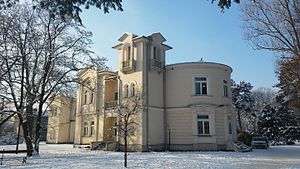Palais Koelichen
| Koelichen Palace | ||
|---|---|---|
| Creation time : | around 1800 | |
| Castle type : | palace | |
| Conservation status: | Reconstructed | |
| Place: | Warsaw | |
| Geographical location | 52 ° 12 '24.2 " N , 20 ° 54' 43.4" E | |
|
|
||
The Koelichen Palace (Polish: Pałacyk Koelichenów ) is a small palace that was built in the late 18th century. It is located in Warsaw 's Włochy district on Ulica ks. J. Chrościckiego 2 (until 1990: Ulica Mikowa ). The building is located in Kombattantenpark (Polish: Park Kombatantów ). Today the palace is used as a public library ( Biblioteka Publiczna w Dzielnicy Włochy ).
History of the palace
As far as is known, the current building was built around 1800 by Count Tadeusz Antoni Mostowski (1766–1842), an important politician and publisher in the later Duchy of Warsaw . The palace initially served as Mostowski's residence. The area (then outside Warsaw) previously belonged to the magnate family Leszczyński . Presumably at the same place or nearby, Andrzej Leszczyński had a residential building built in 1650, which was used in the summer and in 1671 the East Frisian Ulrich von Werdum (1632–1681), an opponent of the then Polish King Michael I , hid . Later the Lubomirskis and Konstancja Plater owned the property. Shortly before the sale to Mostowski, the Prussian King Friedrich Wilhelm II had also taken camp here.
The park surrounding the residence was laid out by an A. Szubert at the beginning of the 19th century. In 1842, the English landscape gardener F. James was hired to remodel in the English landscape garden style . At the same time, the palace facade was probably redesigned in the neo-renaissance style. In 1844 - two years after Mostowski's death - the plant became the property of Andrzej Koelichen, an entrepreneur from a family from Silesia who was active in the flourishing textile and brick industry in Włochy. Around 1859 Edward and Karol Emil Koelichen rebuilt the palace based on a project by the architect Aleksander Zabienowski.
In 1928 the palace and park complex became part of the Włochy Garden City , which was built here on the instructions of the then Warsaw Mayor Zygmunt Słomiński . Part of the park was parceled out for this purpose. In 1936 a city library was housed in the building. The palace itself probably remained in the ownership of the Koelichen family until the end of World War II .
An infirmary was set up in the building during the war. The palace, which is now used as a library, has an irregular floor plan and structure and bears traits of eclecticism . The palace is a listed building. The silhouette of the palace is now part of the coat of arms of the Włochy district. There are trees in the park such as the maple- leaved plane , the American tulip tree , maple and linden . Several of these trees are marked as natural monuments.
Deportation point
On September 16, 1944, German units rounded up around 4,200 male, 16 to 60-year-old residents of Włochy in the park of the palace as part of the suppression of the Warsaw Uprising . They were taken to transit camp 121 Pruszków on the railway that ran here and from there distributed to various concentration camps - for example to Groß-Rosen , Buchenwald , Mittelbau-Dora , Flossenbürg , Dachau , Mauthausen , Ravensbrück , Bergen-Belsen and Sachsenhausen . 2072 of the men were murdered in a row. Two memorial stones in the park commemorate this event.
Individual evidence
- ↑ Mostowski was also the owner of the Mostowski Palace in downtown Warsaw
- ↑ The Mostowski facility may also have been inherited
- ↑ according to Information on Kombatantów Park on the City of Warsaw website (in Polish, accessed on January 19, 2013)
- ↑ according to Monument protection register, reg. No. 710 of July 1, 1965
- ↑ according to Information on the history of Włochy: Historia Włoch ( page no longer available , search in web archives ) Info: The link was automatically marked as defective. Please check the link according to the instructions and then remove this notice. on the district website (in Polish, accessed January 19, 2013)
- ↑ according to Information on the national memorial stone: Miejsca pamięci narodowej on the Włochy District website (in Polish, accessed on January 19, 2013)
- ↑ according to an inscription on a memorial stone on the grounds of the park (in Polish)
See also
literature
- Julius A. Chroscicki and Andrzej Rottermund, Architectural Atlas of Warsaw, 1st edition, Arkady, Warsaw 1978, p. 169
Web links
- Kombatantów Park near Warszawa Wikia (in Polish)
- Urząd Dzielnicy Włochy m.st. Warszawy (Ed.), Dzielnica Włochy , p. 3 ff (PDF; 2.4 MB), ISBN 978-83-928365-2-0 , Warsaw 2011 (in Polish)




